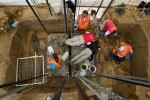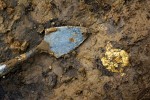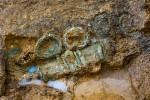 Archaeologists surveying the site of highway construction in Warcq, a town in the Ardennes department of northeastern France, have unearthed a rare Gallic chariot tomb from the first to mid-second century B.C. Inside the tomb is an aristocrat of Remi tribe, one of the first Celtic tribes to have settled Gaul. They buried their aristocrats in pits, resting on top of their chariots, since the 6th century B.C. and several hundred of them have been unearthed in the region.
Archaeologists surveying the site of highway construction in Warcq, a town in the Ardennes department of northeastern France, have unearthed a rare Gallic chariot tomb from the first to mid-second century B.C. Inside the tomb is an aristocrat of Remi tribe, one of the first Celtic tribes to have settled Gaul. They buried their aristocrats in pits, resting on top of their chariots, since the 6th century B.C. and several hundred of them have been unearthed in the region.
 This one is unique, however, for several reasons. It is exceptionally large at five square meters (54 square feet), dwarfing the other known tombs of this type. It was also found intact, untouched by tomb robbers, and in an exceptional state of preservation. The waterlogged clay soil has preserved most of the timber framing, including the roof which has collapsed on the tomb contents. The late date of the burial is also exceptionally rare. Most Remi chariot tombs date to the start of the second Iron Age (5th-4th century B.C.).
This one is unique, however, for several reasons. It is exceptionally large at five square meters (54 square feet), dwarfing the other known tombs of this type. It was also found intact, untouched by tomb robbers, and in an exceptional state of preservation. The waterlogged clay soil has preserved most of the timber framing, including the roof which has collapsed on the tomb contents. The late date of the burial is also exceptionally rare. Most Remi chariot tombs date to the start of the second Iron Age (5th-4th century B.C.).
 The team has not yet been able to determine if the human remains belonged to a man or a woman. A man, a chieftain and military leader, is the likelier candidate, but women have been found in chariot tombs as well. Forensic anthropologists will attempt to determine sex from the skull and pelvic bones, but if they’ve sustained too much damage to be identifiable, the grave goods will help pinpoint whether a woman or a man was buried there. Military artifacts will point to a man’s burial, household goods to a woman’s. To the left of the skeleton archaeologists found some beads, but they were probably part of the deceased’s coat rather than grave goods in their own right.
The team has not yet been able to determine if the human remains belonged to a man or a woman. A man, a chieftain and military leader, is the likelier candidate, but women have been found in chariot tombs as well. Forensic anthropologists will attempt to determine sex from the skull and pelvic bones, but if they’ve sustained too much damage to be identifiable, the grave goods will help pinpoint whether a woman or a man was buried there. Military artifacts will point to a man’s burial, household goods to a woman’s. To the left of the skeleton archaeologists found some beads, but they were probably part of the deceased’s coat rather than grave goods in their own right.
 The metal strapping from the two wheels of the chariot has survived, and amazingly enough, so have fragments of gold leaf that archaeologists believe once coated the inner wheel. The hubs are decorated with bronze features inlaid with glass paste. These precious elements strongly indicate this was a ceremonial chariot rather than a utilitarian piece.
The metal strapping from the two wheels of the chariot has survived, and amazingly enough, so have fragments of gold leaf that archaeologists believe once coated the inner wheel. The hubs are decorated with bronze features inlaid with glass paste. These precious elements strongly indicate this was a ceremonial chariot rather than a utilitarian piece.
 Buried with the deceased were four horses. They were quite petite, 4’3″ at the withers, and were sacrificed specifically to accompany their master on his or her journey to the afterlife. Their skeletons appear to be intact at this point. The skull of one of them was lodged under one of the wheels of the chariot, but the bones of two horses buried along the western wall are still articulated. Four horses are another unusual feature in a Remi chariot tomb. The common find is a simple pair of horses. The remains of a fifth smaller animal (possibly a pig) have also been unearthed.
Buried with the deceased were four horses. They were quite petite, 4’3″ at the withers, and were sacrificed specifically to accompany their master on his or her journey to the afterlife. Their skeletons appear to be intact at this point. The skull of one of them was lodged under one of the wheels of the chariot, but the bones of two horses buried along the western wall are still articulated. Four horses are another unusual feature in a Remi chariot tomb. The common find is a simple pair of horses. The remains of a fifth smaller animal (possibly a pig) have also been unearthed.
 This survey was only scheduled to last three weeks before highway construction began, so the archaeologists are battling against time to get everything out of the grave with proper deliberation. Officially they have three days left, but they have far more to do than can be done in such a short window. In order to excavate the full site, they have to remove the collapsed ceiling planks. They can’t just yank them out, though, because they’re incredibly rare artifacts in their own right. Instead, each plank has to be coated in plaster strips to ensure they maintain structural integrity before being moved very slowly to keep them intact.
This survey was only scheduled to last three weeks before highway construction began, so the archaeologists are battling against time to get everything out of the grave with proper deliberation. Officially they have three days left, but they have far more to do than can be done in such a short window. In order to excavate the full site, they have to remove the collapsed ceiling planks. They can’t just yank them out, though, because they’re incredibly rare artifacts in their own right. Instead, each plank has to be coated in plaster strips to ensure they maintain structural integrity before being moved very slowly to keep them intact.
The President of the General Council of the Ardennes, Senator Benedict Huré, has assured the archaeologists that they will have all the time they need to properly excavate the tomb, “a week or more if necessary.” That’s not exactly a reassuringly generous offer, but the alternative is to rebury everything and pave it over, so here’s hoping they get the time they need to do a thorough job of extracting the archaeological remains.